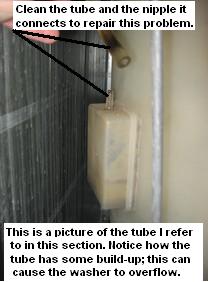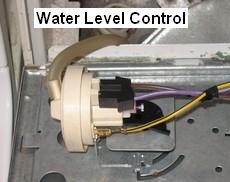GE Washer Leaking Repair Guide
your GE washer leaking? A leaking washer can destroy your floor so it’s very important that you repair your washer immediately. Fortunately for you this washer repair guide will walk you through the steps it takes in repairing your GE washer. These are the same steps I take when repairing washers professionally. So read each section carefully and your washer will be fixed in no time.
If you need a part You can enter your model number or part number here to search the part you need.
It’s easy! Just find the model number of the appliance you are working on. Next, type it in to the model number box and it will take you to an illustrated parts diagram for your appliance. Then just simply choose the part you need from the diagram. If you need help finding your model number click here
LEAKS ALL THE TIME
Is your GE washer leaking all the time, even when not in use? If so the problem is the fill hoses or the valve. Look behind the washer to see if water is coming from the hoses. If not, take the cover off to the control panel. Once off, you should see if the water valve and if there is leakage - it needs replacing (if it is leaking). This is the most popular water valve for GE top-loading washers made after 1995 and the part number is WH13X86 Order Here. . Note that some models have a water valve with more than two coils. In this case, you will need to order the valve by model number at AppliancePartsPros.com Buy Fill Hoses Here.
LEAKS DURING FILL CYCLE
Is your GE washer leaking during the fill cycle? If so the problem may be in the valve. Follow instructions above, only this time start the fill cycle before looking at the valve.
If your washer overflows with water during fill cycle your problem is the water level control or the water valve. If you must cut the water off from the house plumbing to stop the water then there is no need for testing, just replace the water valve.
First, you need to turn on the washer. The washer should start to fill with water, now cut the washer off and on repeatedly (note to yourself whether the water turned off every time). If it does cut off every time you cut the washer off, then it’s most likely in the water level control.
If it keeps running after you cut the washer off then, the water valve is bad and needs replacing. (Note that the valve can stick intermittently so it still may be bad if it passed the test) Water valves can be purchased at AppliancePartsPros.com
If the water valve doesn’t stick in the first test then you need to check the water level control.

First, remove the front of washer (insert butter knife between the top and the front pushing on the clips) then look on the side of the tub and you should see a tube attached to a box.
Remove the tube (make sure all the water is out of the tub) look in the tube to see if is stopped up. Often it will stop up near the end. If it is, you can clean it out with a stiff wire. Sometimes it is helpful to stray all-purpose cleaner in the tube. Also clean out the nipple that the tube connects to. Once it’s clean, reinstall it and your washer is fixed.
If the tube is not stopped up reinstall the tube. Now set the water level control on the lowest setting and start filling the washer with water. If the water stops when the tub is approximately half full (this varies with every model) turn it up to the next level (you may have to reset it).

Repeat until the tub is full. If at any the water level gets above the last row of holes in the tub, unplug the washer. If the water stops running when you unplug the washer, replace the water level control. If the water doesn’t stop, turn the water off at the wall then replace water valve. Water level contorls and water valves can be purchased at AppliancePartsPros.com .
LEAKS DURING WASH
Is your GE washer leaking during wash? If so the problem is the tub seal (seals around the transmission where it goes through the tub), drain hoses (including the tub to pump hose) or the pump. First take the front off the washer (insert butter knife between the top and the front, pushing on the clips) then start the fill cycle. Now start watching until you see a leak. If the leak is coming from the tub seal, refer to this page
GE Washer Leaking and noisy (tub seal and bearing replacement)
If the leak is coming from the drain hose or the pump you need to replace it. If you don’t see it leak at all, your soap may be the problem. To check this fill the washer with water and the amount of soap you normally would use. Then start the washer and watch the tube coming from the left back of the tub (the overflow pipe). If soapsuds come out of the overflow pipe then try cutting down on your soap or switch to another brand. This may fix your problem. These parts can be purchased at AppliancePartsPros.com
LEAKS DURING PUMP OUT
Is your GE washer leaking during pump out? If so the first thing you should look at is the drainpipe (to your house plumbing). Fill the washer with water, and then turn it to spin and start it. Now while it’s pumping, look at your drainpipe if water backs out (it may not back unless you have soap in the tub), then the problem is in your plumbing. If it doesn’t, follow the same steps as above in “leaks during wash.” Only this time watch for leaks during pump out as well.
If you have figured out the problem with your GE washer but can’t seem to get it apart this page will help GE Washer Disassembly.
Return From GE Washer Leaking Repair Guide